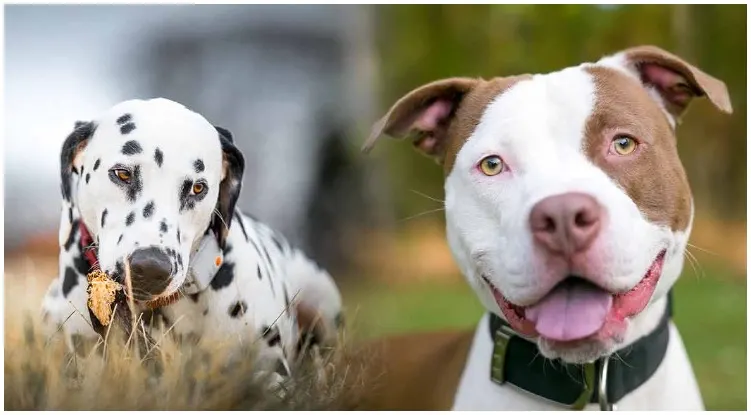The Dalmatian Pitbull mix is a rare and fascinating combo of a Dalmatian and an American Pitbull Terrier. Known for it’s unique combination, this crossbreed is rapidly gaining popularity among designer breeders.
As with many other mixes, the Pitmatians don’t have too long of a history. This lovely mix came as a result of the breeders wanting to create an energetic and agile dog. They are not only protective but people-friendly too. Keep in mind that these dogs are full of energy and life. Be sure that your puppy can be easily identified as a Dalmatian with all the spots. But it will still have some Pitbull in him. This creates some kind of balance.
Want to learn more about them, their personality, and their health? Keep reading!
Appearance of the Dalmatian Pitbull Mix
As we said earlier, the Pitmatian being a mixed hybrid, its appearance entirely depends on dominant genes that it inherits. The thing is that it is only after a certain age that accurate predictions about its looks can be made. Nonetheless, these dogs are large, well-muscled, and powerful. They weigh around 45 to 70 pounds with a height of 18-24 inches. But male Pitmatians usually have more weight than their female companions.
So, as we know, the Dalmatians have a white base with black spots. Meanwhile, Pitbulls have a patched, black, white, brown, tan, red, or fawn-colored coat. The final product of the Pitmatians looks a lot like Dalmations with a white base and spots that are either black or liver-colored.
History and Origin of Dalmatian Pitbull Mix:
We’ll just describe their history in a few sentences. Let’s begin. The Pitmatian comes from a lineage of the Dalmatian and the American Pitbull Terrier. But very little information is available as to when are where they first originated.
Based on the first appearance, many designer breeders believe that they originated in the early 2000s. If you didn’t know, these dogs developed in the era when the designer breeders were breeding pure breeds for a new hybrid dog.
Training Requirements:
Just to let you know, if you didn’t, both the Pitbull and the Dalmatian are intelligent breeds, so as a prospective owner of the Pitmatian, you will find it easy to train the puppy. However, even though it is an enjoyable process, you should be familiar with your dog’s stubborn side.
Since it’s a large dog, it needs house training and obedience training from quite a young age. Fortunately, your puppy has a Dalmatian in it, and the Dalmatians are good with obedience training. By the time you will teach your dog that you are the master and that it should follow all your commands.
Grooming Requirements:
As we mentioned earlier many times, the Pitmation is a mix of the Dalmatian and the Pitbull, and this makes it quite effortless for you to manage it. So let you know that your puppy will most likely have a short and silky coat that is straight and even in texture. Be sure that brushing its coat about once a week should be sufficient to maintain it in good condition.
However, if your puppy is a heavy shedder like its Dalmatian parent, then it would need regular brushing to get rid of loose hair and debris. Just do the proper and regular grooming from its young age is more likely to reduce the shedding.
When you want to shower your dog, give it a bath with shampoo for dogs whenever your puppy gets dirty. Other than this, they do not need regular bathing.
Health issues of the Dalmatian Pitbull mix
The Pitmatian breed is prone to the same health conditions that the parent breeds face.
If you didn’t know, both parent breeds are vulnerable to several health issues—for instance, deafness. The Pitmatians are highly prone to Canine Congenital Sensorineural Deafness (CCSD) that is linked to a gene named MITF (microphthalmia-associated transcription factor). As with everything else, the gene determines the pigmentation, and the extreme white colour with black spots is the cause of CCSD.
Besides this, the Pitmatians are highly prone to having urinary stones that are caused by a gene called SLC2A9. This gene produces a high amount of uric acid, ultimately leading to urinary stones.
In the end, we’ll mention few other health risks that this breed can have:
- hypothyroidism
- hip dysplasia
- cardiac diseases
- allergies
- eye diseases

